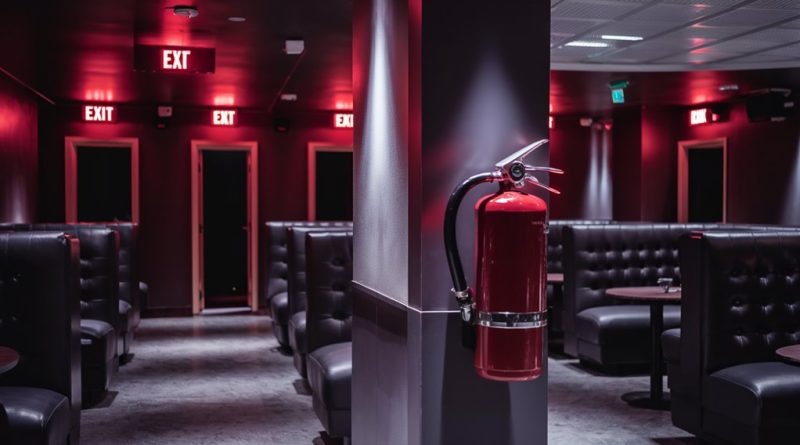How to Evaluate Karaoke Lounge Safety Before You Book
How to Evaluate Karaoke Lounge Safety Before You Book
When selecting a karaoke venue, thorough safety evaluation is essential for an enjoyable experience. Conduct a comprehensive assessment of these critical safety elements before making your reservation.
Essential Safety Checklist
Emergency Exit Accessibility
Verify multiple emergency exits with unobstructed pathways and bright, functioning illuminated signage. All exits should be easily accessible from any point in the venue, particularly from private karaoke rooms.
Occupancy Management
The venue must strictly enforce room capacity limits and implement effective crowd control measures. Look for posted occupancy signs and staff actively monitoring guest numbers in both common areas and private rooms.
Professional Staff Presence
Observe staff conduct and ensure qualified personnel are present. A visible manager should be on duty, and employees should demonstrate knowledge of safety protocols and emergency procedures.
Ventilation Standards
Proper air circulation is crucial in enclosed singing spaces. The ventilation system should maintain fresh air flow throughout all areas, preventing stuffiness and maintaining appropriate humidity levels.
Equipment Safety
Inspect the technical setup thoroughly. All electrical equipment should be properly secured, with cables safely tucked away. Microphones must be clean and well-maintained, showing regular sanitization practices. Sound systems should be professionally installed with appropriate surge protection.
Emergency Exits and Fire Safety
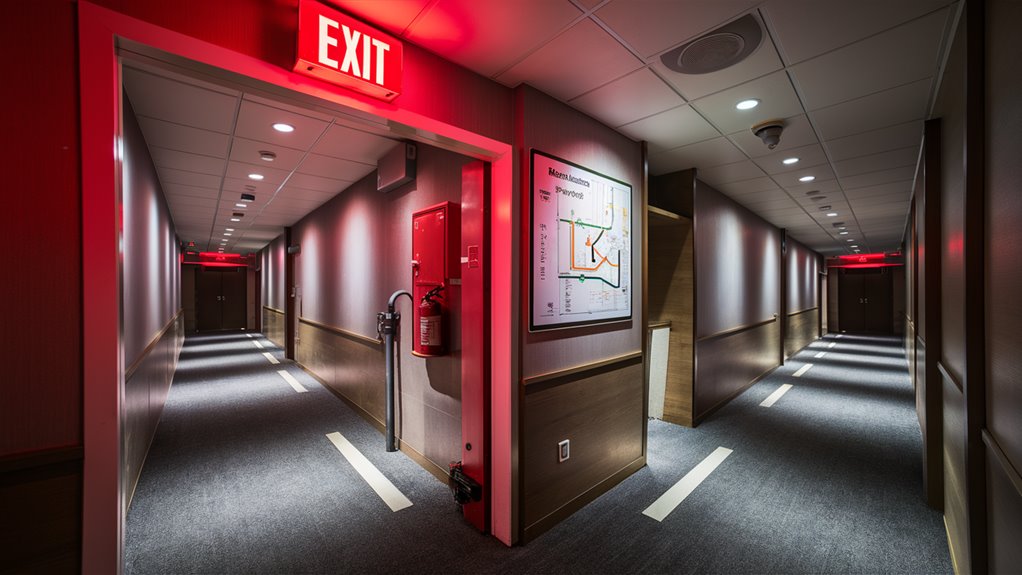
Emergency Exits and Fire Safety in Karaoke Venues
Critical Safety Infrastructure
Emergency exits and fire safety equipment serve as essential protective measures in karaoke lounges.
Professional venue inspection requires thorough verification of illuminated exit signs and unobstructed pathways.
Maintaining clear access routes free from furniture, equipment, or decorative elements ensures swift evacuation during emergencies.
Fire Prevention and Suppression Systems
Fire safety compliance demands properly mounted fire extinguishers in high-visibility locations, particularly near stages and electrical equipment zones.
A comprehensive fire protection system includes:
- Fully operational sprinkler networks
- Unobstructed sprinkler heads
- Regularly maintained smoke detectors
- Clearly marked evacuation routes
Emergency Exit Requirements
Essential Safety Features
Emergency exit doors must meet strict safety standards:
- Outward-swinging door mechanisms
- Panic hardware installation
- Immediate accessibility without special tools
- Complete absence of locks or chains
- Visible evacuation maps
- Posted maximum occupancy limits
Venues failing to demonstrate these mandatory safety measures and emergency protocols present unacceptable risks and should be immediately disqualified from consideration for events or performances.
Room Capacity and Crowd Management
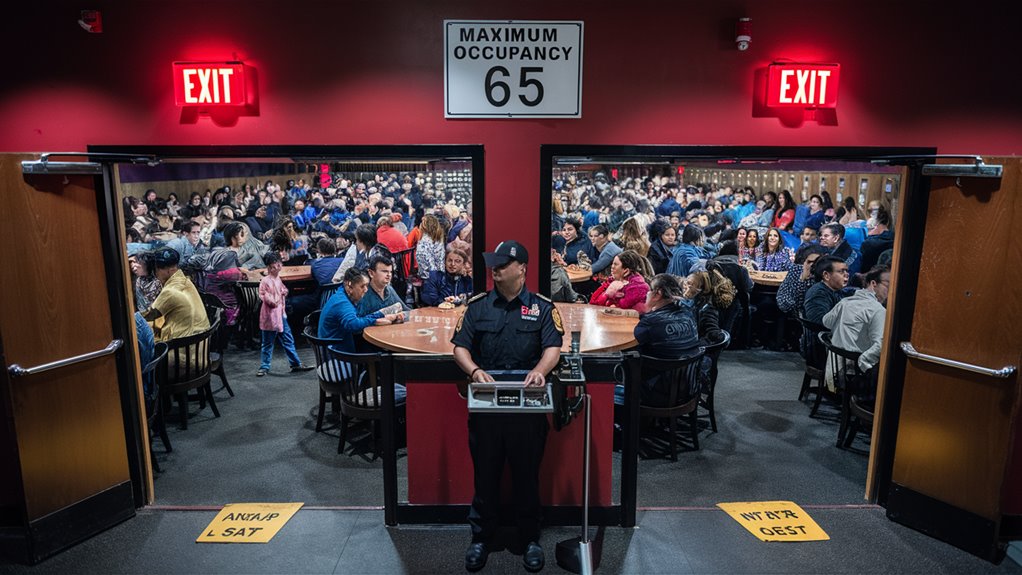
Room Capacity and Crowd Management Guidelines for Karaoke Venues
Understanding Maximum Occupancy Requirements
Karaoke venues must strictly enforce designated room capacity limits to maintain safety standards and legal compliance.
Each room and common area should display clearly visible occupancy limit signs near entrances.
Professional venues maintain strict adherence to these capacity restrictions during all operating hours, including peak times.
Essential Crowd Management Protocols
Effective crowd control measures are crucial for karaoke establishment safety. Key protocols include:
- Digital reservation systems
- Timed entry slots
- Queue management procedures
- Real-time occupancy monitoring
- Peak period control measures
Space Planning and Room Selection
Optimal Space Requirements
Room size calculations should account for active participation, with a minimum of 15 square feet per guest recommended for comfortable movement. Consider these factors when selecting karaoke rooms:
- Standing space requirements
- Dance floor allocation
- Equipment placement
- Movement patterns
- Emergency exit access
Capacity Planning
Event organizers should select rooms exceeding minimum group size requirements to accommodate:
- Unexpected additional guests
- Comfortable spacing between participants
- Performance areas
- Equipment setup
- Ventilation requirements
Staff Training and Security
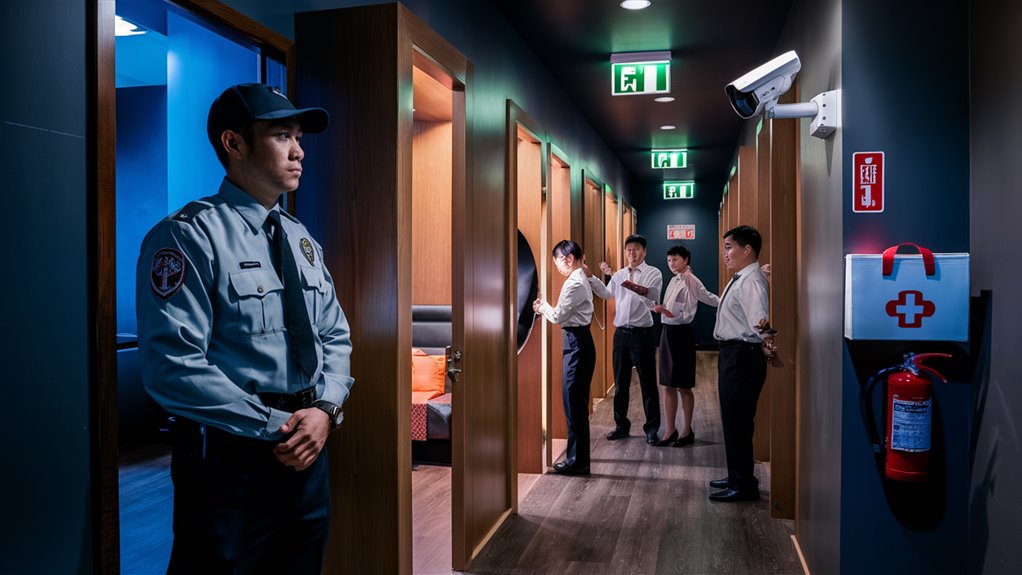
Essential Staff Training and Security Protocols for Karaoke Venues
Professional Training Requirements
Staff safety certification and comprehensive security measures are fundamental to operating a secure karaoke establishment.
Successful venues implement mandatory training programs covering emergency procedures, crowd control techniques, and conflict de-escalation.
Security personnel must wear distinct uniforms and maintain strategic positioning throughout the facility to ensure optimal coverage and rapid response capabilities.
Safety Implementation and Monitoring
Establishments must conduct regular safety drills and maintain current emergency protocols.
Front desk operations require strict ID verification systems and systematic patron screening procedures. Staff must demonstrate expertise in alcohol consumption monitoring and patron management.
A robust surveillance system should provide complete coverage of all venue areas, with particular attention to corridors and private room entrances.
Communication and Management Systems
Effective internal communication relies on professional-grade two-way radios or equivalent systems for real-time staff coordination.
Every shift requires an authorized venue manager capable of executing immediate decisions during emergencies.
Strong law enforcement partnerships and clear emergency response protocols are essential components of a venue's security infrastructure. These integrated systems create a comprehensive safety framework that maximizes patron and staff protection while minimizing security risks.
Ventilation and Air Quality
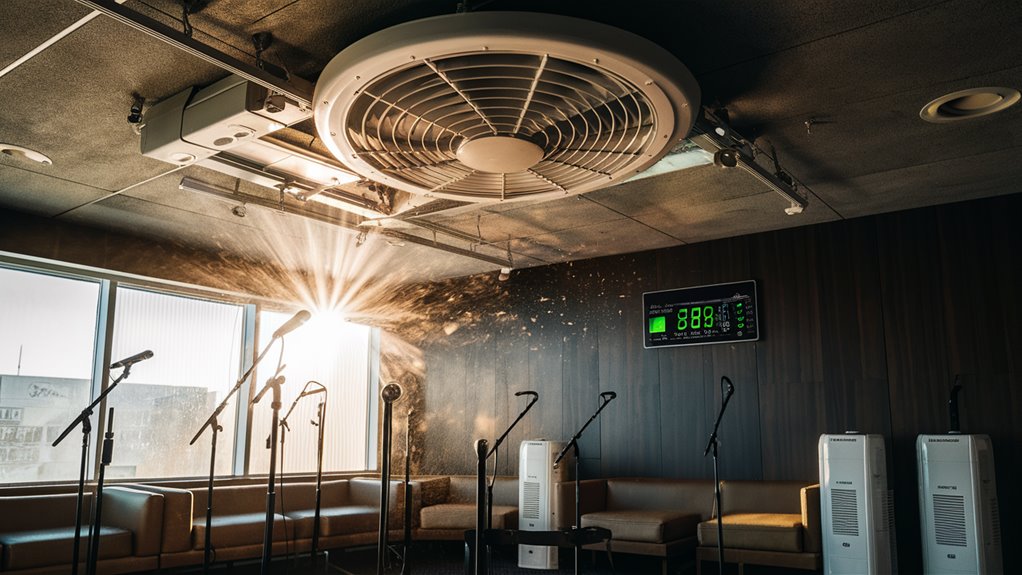
Ventilation and Air Quality in Karaoke Venues: Essential Guidelines
Professional Ventilation System Requirements
A properly engineered ventilation system forms the foundation of optimal air quality in karaoke establishments.
Essential components include strategically positioned air vents throughout the venue, with particular emphasis on individual singing rooms where air circulation challenges commonly arise.
The airflow pattern should maintain consistent movement without disrupting acoustic performance or vocal projection.
Key Air Quality Indicators
Critical ventilation markers demand careful monitoring in karaoke spaces. Watch for these essential indicators:
- Proper humidity levels (30-50% range)
- Temperature regulation systems
- Air filtration mechanisms
- HVAC maintenance protocols
- Carbon dioxide monitoring equipment
Private Room Ventilation Standards
Individual karaoke rooms require specialized ventilation considerations to maintain optimal air quality. Essential features include:
- Dedicated temperature controls
- Independent air returns
- CO2 monitoring systems
- Multi-point ventilation outlets
Warning Signs of Poor Ventilation
Monitor these air quality red flags:
- Persistent stuffiness
- Stagnant odors
- Window condensation
- Wall moisture accumulation
- Patron respiratory discomfort
- Chronic coughing incidents
- Frequent headache complaints
Equipment and Electrical Safety
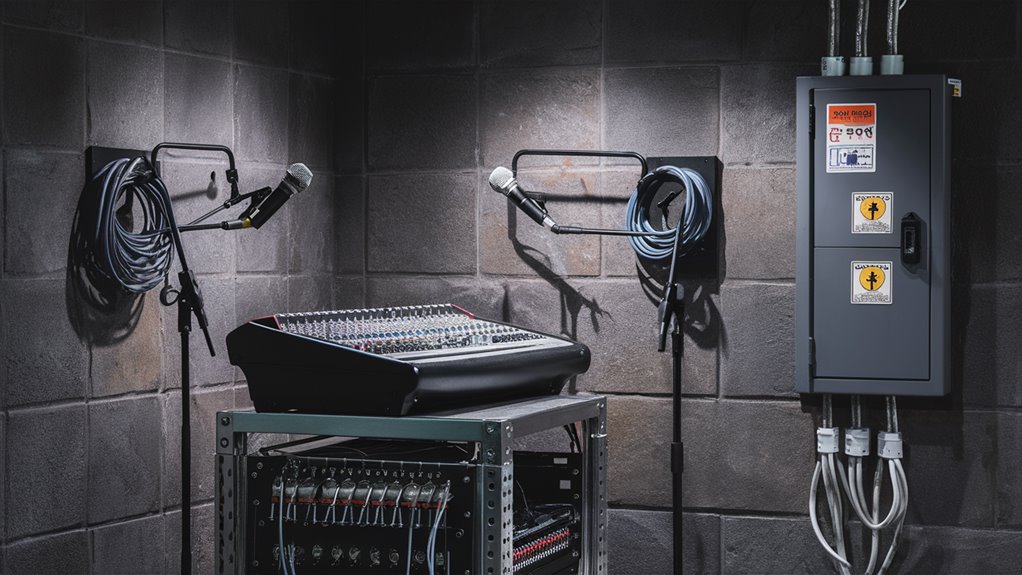
Equipment and Electrical Safety in Karaoke Venues
Essential Safety Protocols for Karaoke Equipment
Proper electrical safety management in karaoke venues demands strict adherence to established protocols to prevent hazardous incidents.
Professional equipment inspection must focus on comprehensive cable management, ensuring no exposed wires or frayed cords exist around critical audio components like microphones, speakers, and amplifiers.
Electrical grounding standards must be maintained, with careful monitoring of outlet capacity to prevent dangerous overloading scenarios.
Maintenance and Equipment Standards
Regular equipment maintenance serves as a cornerstone of venue safety protocols.
Audio equipment inspection should reveal consistent cleaning practices and proper upkeep of all components.
Electrical safety compliance requires secured access to main panels while maintaining clear visibility of emergency shutoff mechanisms. All safety controls must remain readily accessible to authorized personnel.
Critical Safety Considerations
Liquid hazard prevention demands strategic separation between drink service areas and electrical installation zones.
Venues must maintain appropriate fire suppression equipment, specifically rated for electrical fires.
Safety red flags include:
- Extension cords across walking paths
- Multiple connected power strips
- Evidence of water-damaged equipment
- Expired safety certifications
Venue safety documentation should include current electrical certifications and detailed inspection records, available for review upon request. These measures ensure comprehensive protection against electrical hazards while maintaining operational excellence in karaoke establishments.
